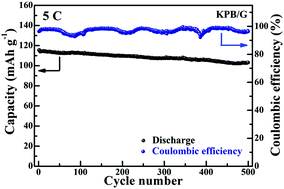Although Prussian blue analogues (PBAs) show promising applications as cathodes for potassium-ion batteries (PIBs), it remains a challenge to synthesize high-performance PBAs enabling fast/reversible K-ion diffusion. Herein, we report the synthesis of a high-performance potassium manganese Prussian blue/graphene (KPB/G) nanocomposite obtained via a facile ball-milling method. It was found that after ball milling with graphene, the KPB particles were broken into small grains that were homogeneously loaded onto the few-layered graphene. The nanocomposite demonstrates a high initial discharge capacity (131.4 mA h g−1 at 0.1C), a high average working potential (∼4 V at 0.1C), superior rate capability (108.8 mA h g−1 at 5C and 100.2 mA h g−1 at 10C) and long cycle life (96.9% after 120 cycles at 0.5C, 89.3% after 500 cycles at 5C, and 82.4% after 300 cycles at 10C). The excellent electrochemical performance of KPB/G is due to the small size of KPB and the conductive and protective effects of graphene. This work provides a facile method to synthesize Mn-based Prussian blue for high-performance potassium-ion batteries.
